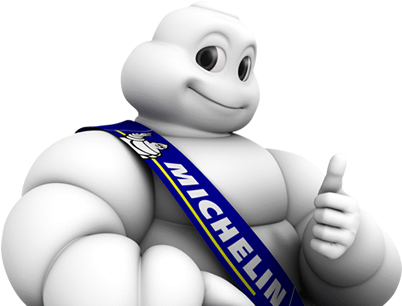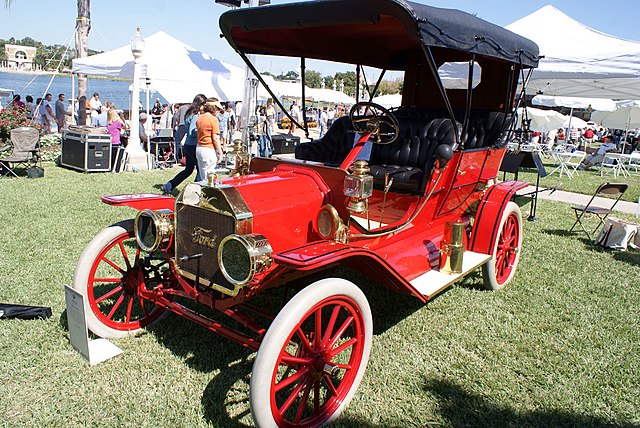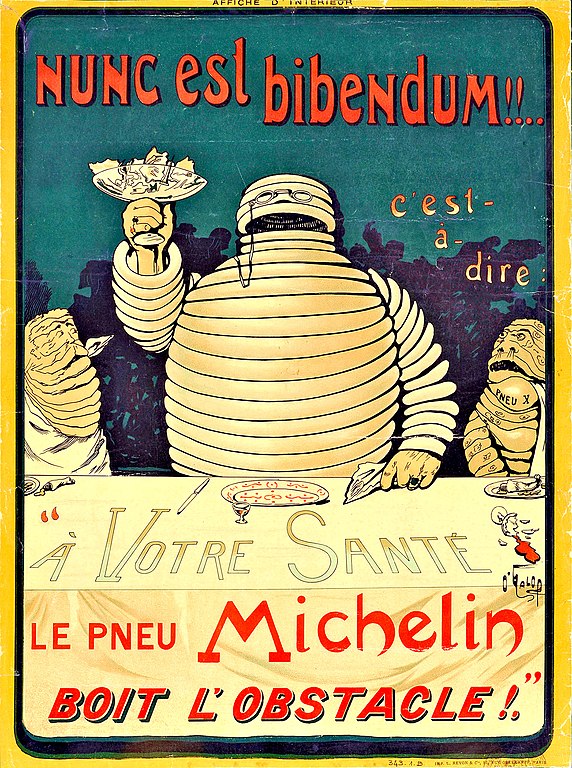Why the Michelin Man is White (and Maybe an Alcoholic)

The character pictured above is commonly known as the Michelin Man. He’s the mascot for Michelin, the company that makes automobile tires. If you weren’t familiar with him before, you may have thought he was a cousin of the Pillsbury Doughboy or perhaps a more muscular version of the Stay Puft Marshmallow Man. Those two mascots, though, kind of make sense — the doughboy looks like a pile of raw dough (but with a hat) and the marshmallow man looks like a big angry marshmallow (again with a hat). The Michelin Man, though, doesn’t have a hat, and more importantly, looks more like a doughboy in a muscle suit than anything resembling a car tire. What’s going on here?
Michelin, the company, got its start in 1892, at first making tires for bicycles. Those tires were made from the latex that came from rubber trees, or just “rubber” in today’s terms. Previous tires were made from wood, metal, or leather, but all of those materials quickly fell prey to the normal wear and tear of transversing across bumpy, informal roads and paths; the wheels they ended up protecting would crack, and usually while in transit. Rubber tires were able to adjust somewhat to the terrain and lasted a lot longer, and rubber quickly became the material of choice for the wheels of would-be motorists. The tires we use today are still made, primarily, of rubber.
But while the tires of today are black, natural rubber isn’t. Rubber, in its natural form, is white, as seen here. And when Michelin was founded, they made white tires. Here’s a restored Ford Model T from 1909, and you’ll see immediately that the tires it sports are thin, white ones.

In 1894, Édouard and André Michelin, the founders of Michelin, were the Universal and Colonial Exposition in Lyon, France, when they came across a bunch of these tires stacked, with the larger ones forming the base and the smaller ones at the top. Édouard, the story goes, remarked that the pile looked like a man, minus the arms, and the thought stuck with André. He commissioned an artist to create a character from this concept, with the below — a pile of tires wearing glasses and with some creepy-looking hands — was one of the original results. The Michelin Man was born.

Over the years, two things have changed. First, the Michelin Man has become a lot more human-looking, leaving behind its mummy-like origins in favor of a more cartoony, muscular look. And second, tires have gotten better. Over the past century-plus, scientists have looked for ways to make tires last longer, and in the early 1910s, some discovered that adding a material called “carbon black” to the manufacturing process made a huge difference. The added carbon makes the tires more resistant to temperature changes, helps the rubber wear down more slowly, and generally makes the tires stronger. That sums up to big gains. Tires with carbon black are often good for 50,000 miles, but according to Goodyear, “chemical engineers have found that a tire made without carbon black would likely last 5,000 miles or less.” The carbon additive gives tires ten times more life — and it also makes them black.
But while tires have changed color, the Michelin Man hasn’t. Most likely, that’s because the mascot was already well established before the advent of carbon black — there’s no evidence that he was kept white for reasons having to do with race. He’s still just a pile of tires with a face and some arms — it’s the tires that have changed, not the tire man.
Bonus fact: The Michelin Man has a name: “Bibendum.” And it has nothing to do with tires. “Bibendum” is Latin for “drink,” as in to down a martini or glass of wine. If you take another look at that early ad pictured above, you’ll see a bunch of copy on it, with the word “bibendum” included; it translates to “Now is the time to drink!! Which is to say: ‘To your health, the Michelin tire drinks down the obstacle[s]!'” Early ads featuring Bibendum often made references to drinking, as cars — and therefore tires — were owned mostly by the very rich, and Michelin used ad copy and imagery reflective of those living the high life. Bibendum — who, again, is literally named “Drink” — got a reputation for having a drinking problem as a result; per Town Fair Tire, “this led to the character being known for a while as the ‘road drunkard,’ an image that would be abhorrent to any car-related company today.”
From the Archives: Fordlandia: How rubber tires led to a weird Ford-owned city in Brazil (and a revolution).
